 |
||
|
||
| ||
Synthetic testsTestbed:
Our synthetic benchmarks:
Tested graphics cards:
We selected them to compare with GeForce GTX 295 for the following reasons: RADEON HD 4870 X2 is the primary rival both in price and features; GeForce GTX 280 acts as the most powerful (at the moment of testing) single-chip graphics card, its results will help us see performance gains from two GPUs; finally, comparisons with two SLI configurations based on GeForce GTX 260 and GTX 280 will tell us how a single card with two GPUs stands up to its SLI counterparts. Direct3D 9: pixel filling testsAll multi-GPU systems from NVIDIA with test drivers demonstrated clearly incorrect results in peak tests of texture sampling and fill rates. Their results were dozen times as low as theoretical values of texture sampling and fill rates, as well as corresponding results of a single-GPU card -- GeForce GTX 280. There is no point in analyzing such results, so we don't publish them -- it's an apparent bug in the drivers. Direct3D 9: pixel shaders testsThe first group of pixel shaders to be reviewed here is too simple for modern GPUs. It includes various versions of pixel programs of relatively low complexity: 1.1, 1.4, and 2.0. 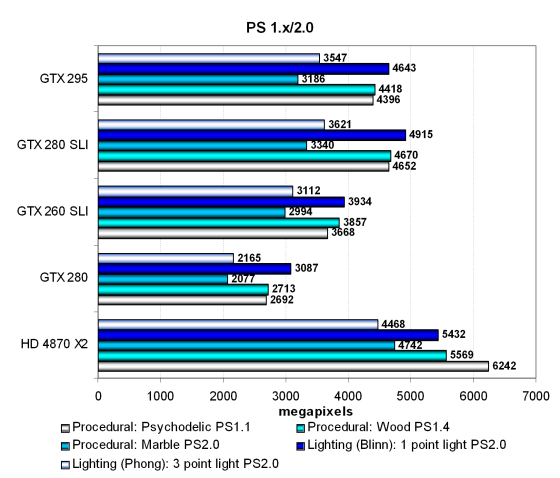 These tests are too easy for modern architectures. They may only come in handy to reveal architectural differences. As performance of simple tests is limited mostly by the speed of texture sampling and efficiency of multi-GPU rendering, GeForce GTX 295 is faster by 60-70% than the single-GPU GeForce GTX 280. What concerns SLI systems, the new card from NVIDIA performs somewhere in between, closer to the GTX 280 SLI, a clear sign that performance is limited by texturing and arithmetic performance. Results of RADEON HD 4870 X2 also show that arithmetic speed is relevant here -- this card outperforms all NVIDIA products, including the GTX 295, in all our tasks. Even the GTX 280 SLI cannot compare with it in our simple tests of pixel shaders due to the improved RV770 architecture. Let's have a look at results in more complex pixel programs of intermediate versions: 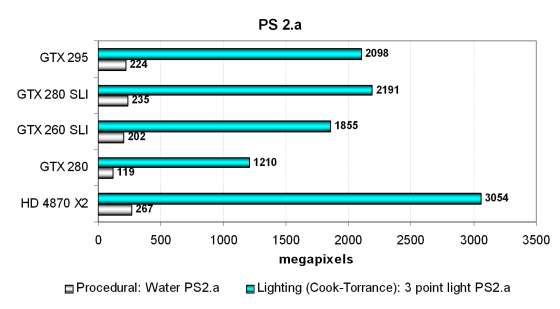 Similar results, and SLI is even more efficient here. AFR almost doubles the frame rate in such synthetic tests and in the procedural water test (which depends much on texturing performance). It uses dependent texture lookups of high nesting depth. The cards line up according to their maximum texturing rates. The new dual-GPU card from NVIDIA is almost twice as fast as the GTX 280 with one GPU, and it's practically on a par with the GTX 280 SLI. But this card is still slower than the HD 4870 X2. The second test is heavier for computing units, so it favors the AMD architecture, which possesses more stream processors and higher theoretical performance. The new card from NVIDIA demonstrates a very high result here, compared to the single-GPU card and SLI systems, but it still cannot compete with the AMD card, which shows the best result again. Direct3D 9: new pixel shaders testsThese tests of DirectX 9 pixel shaders are even more complex, they are divided into two categories. We'll start with easier shaders - SM 2.0:
There are two modifications of these shaders: arithmetic intensive and texture sampling intensive. Let's analyze arithmetic-intensive modifications, they are more promising from the point of view of future applications: 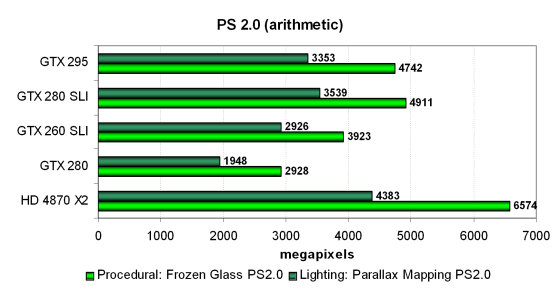 These arithmetic tests depend mostly on frequencies of shader units and texturing speed, so balanced performance of various GPU units is very important here. Performance of graphics cards in the Frozen Glass test is limited not only by arithmetics, but also by the texel rate. And the old architecture from AMD shows a weak result here. But two RV770 GPUs are doing great, the HD 4870 X2 is the winner again. And our product under review outperforms all its fellow cards except for 2 x GTX 280 in SLI mode, which operate at a higher clock rate. The same happens in the second Parallax Mapping test. Even though GeForce GTX 295 outperforms GTX 280 and GTX 260 SLI, and a little slower than GTX 280 SLI (which conforms with the theory), it's outperformed by the dual-GPU card from the HD 4800 series. Judging by our previous reviews, even single-GPU cards from AMD are very good at this synthetic test. And the efficient implementation of AFR in CrossFire lets HD 4870 X2 defeat GeForce GTX 295. Let's analyze results obtained in the texture sampling intensive tests, we may get different results there. 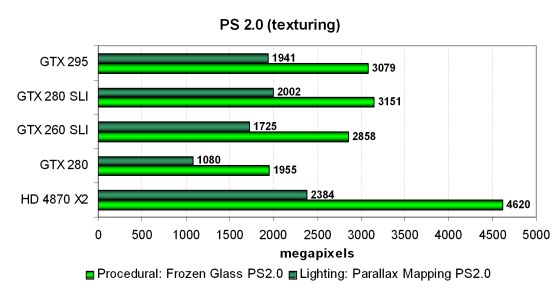 Almost the same here -- RADEON HD 4870 X2 even improved its relative results a little. And GeForce GTX 295 is still close to the system with two GeForce GTX 280 cards and outperforms two GTX 260 cards. Mutual arrangement of cards hasn't changed much. We can see that all modern solutions cope with arithmetics much better than with texture sampling. Let's have a look at results of another two pixel shader tests -- SM 3.0. They are the most complex of all our tests for Direct3D 9 pixel shaders. The tests load ALUs and texture units heavily. Both shader programs are complex, long, and include a lot of branches:
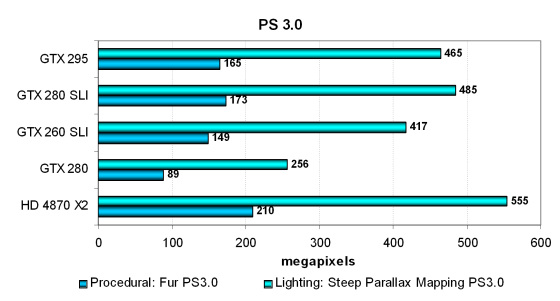 Well, the most complex DirectX 9 tests show that GeForce GTX 295 is a very fast card, almost twice as fast as a single GTX 280, and only a little slower than two such cards. 480 stream processors and 160 texture units help this card demonstrate noticeably higher results than GTX 260 SLI operating at the same frequencies. And the latest architecture from AMD puts up excellent performance in these tests. RADEON HD 4870 X2 outscores all its competitors, not much but actually enough to consolidate its leadership in this part of tests -- it was not defeated in any of them by the latest card from NVIDIA. Let's see what happens in Direct3D 10 tests, where AMD cards have always fared worse than in Direct3D 9. Write a comment below. No registration needed!
|
Platform · Video · Multimedia · Mobile · Other || About us & Privacy policy · Twitter · Facebook Copyright © Byrds Research & Publishing, Ltd., 1997–2011. All rights reserved. |